



Dehorning Of Calves
Neil Anderson, a lead veterinarian with Ontario Ministry of Agriculture looks at the benefits and practice of disbudding and dehorning of calves.Horns are the pairs of hard, bonelike, permanent growths projecting from the heads of cattle. They grow from a unique area of skin cells at the base of the horn. At about two months of age, horns become attached to the frontal bone of the skull. A sinus lies within the skull beneath the horn bud. As the horn grows and attaches to the skull, this frontal sinus joins into the adjacent portion of the horn.
Disbudding And Dehorning Defined
Horned cattle have horns because they have not been dehorned or they are not polled. Some breeds are naturally (genetically) hornless because they do not grow horns. Dehorning of horned cattle is the process of removal of their horns or the process of preventing their growth. A polled animal is one that grew no horns or one that was dehorned. Disbudding by chemical or hot-iron destroys the horn-producing cells of the horn bud. Surgical disbudding removes the horn bud and the horn-producing cells of the horn bud. Dehorning removes the horn and horn-producing tissue after horns have formed from the bud.
Reasons For Dehorning
Advisors commonly recommend dehorning young calves to:
- reduce the risk of injury and bruising to herd mates
- prevent financial losses from trimming damaged carcasses caused by horned feedlot cattle during transport to slaughter
- require less space at the feed bunk and in transit
- decrease risk of injury to farm workers, horses and dogs
- decrease risk of death, illness and setback by dehorning young calves versus older calves
- gain a price advantage by offering hornless cattle at auction
- produce docile cattle that are easier to handle
- decrease aggressiveness at the feed bunk
- enhance on-farm safety for animals, producers and employees
- facilitate easier use of handling facilities
Managing Horned Cattle
Owners may choose to manage their cattle with or without horns. For beef cattle, the selection will depend on the available handling facilities, the producer's ability, the awareness of dehorning effects, and the market available for the calves. Owners with guaranteed buyers willing to purchase green calves (horns and testicles in place) at the same price as processed calves (castrated and dehorned), might be advised to avoid these procedures.
However, this buyer is very rare. Most purchasers of green calves are well aware of the risks associated with processing older calves and routinely bid less at auction. Preconditioned (castrated, dehorned, vaccinated, bunk-adjusted) calves may bring a premium price. Generally, horned cattle are discounted at auction. Breeders of horned Herefords may use methods to train horns to grow in a cosmetically appealing fashion - just like braces on your teeth.
For dairy cattle, naturally polled animals are very rare. Therefore, dehorning is a common management practice on dairy farms. In Ontario, housing systems and milking parlours are designed for dehorned cattle. Organic dairy producers may choose to work with horned cattle. There is a need for housing and feeding equipment designs to accommodate dairy cattle with horns.
Breeding Horns Off Cattle
Dehorning requires labour and imparts risks to the animal and the operator. In addition, producers and consumers have concerns about animal welfare implications associated with dehorning techniques.
Breeding polled cattle is a non-invasive way to dehorn the cattle population. Polled inheritance is very complex. Nonetheless, the beef industry is making steady progress towards dehorning through genetics. Producers may resist breeding strategies to dehorn because of a belief that the polled gene is associated with impaired productivity. To date, research studies show no difference for several important traits between horned and polled cattle.
Within the beef breeds, producers have access to polled genetics. There is scarce availability within the dairy breeds. The industry needs genetic tests to identify horn status and thus, breed polled cattle. Although the gene for polled has not been identified, its position and markers near it are known. Five markers seem to be close enough to provide 90 per cent accuracy of the polled or horned characteristic being inherited by a calf.
A Canadian Expert Committee on Farm Animal Welfare and Behaviour recommends dehorning cattle using genetics as the most welfare friendly technique. The Committee recommends promotion of the use of polled sires within the beef industry in Canada. The use of a naturally polled bull from naturally polled ancestors over horned breeding cows should result in the birth of polled calves. Continuous use of polled bulls over these female offspring should ensure that all calves continue to be polled. This method has obvious advantages where polled breeds are available with production characteristics similar to those of horned cattle.
Dehorning Age
Dehorning at a young age minimizes hazards to the calf, the cow-calf producer, and the feedlot owner. Hazards for calves and owners include:
- sickness or death following dehorning of older calves
- decreased liveweight gains in the weeks following dehorning of older calves
- loss of productivity
- techniques are easier for the operator
- dehorning is less stressful on newborn calves
- of concerns for animal welfare
Although there is no evidence that pain differs between young and older calves, there is less risk with dehorning of young (less than eight weeks) calves.
The cow/calf producer's decision to dehorn and the timing (age) will be influenced by his or her facility, available labour, expertise with the techniques, awareness of the impact of the procedure on calf health and productivity, and market for the calves.
The feedlot purchaser is able to selectively purchase horned or dehorned (polled) cattle with price as well as some of the above factors influencing the decision. In general, dairy calves receive intensive care and producers have an opportunity to dehorn their calves at a young age. It is each owner's responsibility to ensure humane and safe completion of the dehorning procedure on the calves entrusted in their care.
The Canadian Veterinary Medical Association (CVMA) recommends that, when dehorning is necessary, it be performed within the first week of life.
Timing of Operations
Normal management procedures provide a convenient time for dehorning. At one day of age, insertion of an identification ear tag and injection of the calf with vitamin E-selenium dictates that the calf be restrained.
Disbudding could be performed at the same time. Some beef producers prefer to batch the calves up weekly during calving season and dehorn many at one time. Others will catch all calves prior to turning them to grass with their mothers. This may be when calves are six to eight weeks of age and would also be an ideal time to administer the second injection of vitamin E-selenium.
Dehorning at an early age (less than eight weeks) reduces the risk of serious infection because the horn bud is removed without opening the sinus (cavity) into the skull. When surgically dehorning older calves, the sinus is opened. On dairy farms, calves may be dehorned by a veterinarian or her assistant during the monthly herd health visit.
Avoid the summer and autumn periods when dehorning calves. The risk of infection and fly strike is too great. Dehorn in early spring, late fall and winter only.
On each farm, the timing of dehorning will be based on the management system in operation. Dehorning at a young age should suit most management systems.
Economic Significance
At packing plants, trim from bruised carcasses of animals in groups with horned cattle is twice that of comparable groups of hornless cattle. According to the Canadian Beef Quality Audit, bruising costs the industry $10 million a year. Dehorned cattle may incur fewer financial penalties at sale.
Welfare Significance
Livestock owners and veterinarians recognize that some people consider dehorning offensive. Nonetheless, dehorned cattle create a safer workplace for herdmates, handlers and workers - a benefit that outweighs the short period of discomfort at dehorning time.
- All methods of physical dehorning cause pain and side effects.
- Young calves recover quicker and have fewer complications than older calves.
- There is no evidence to show young calves experience less pain than older calves.
- Local anaesthesia prior to dehorning eliminates acute pain for a few hours after dehorning.
- Local anaesthesia, combined with a sedative and an analgesic (pain reliever), may provide the best pain relief.
- Dehorning without anaesthesia is inhumane and unethical.
- Use of pain relief is an additional cost for producers. Pain relief may be limited by the availability of drugs for farmers to use and the scarcity of veterinarians in farm animal practice.
- In Ontario, auxiliaries (technicians) employed by veterinarians may administer local nerve blocks and dehorn cattle less than two months of age while under immediate, direct or indirect, supervision of a veterinarian. They may dehorn cattle greater than two months of age when under immediate or direct supervision.
- Use of polled bulls is a welfare-friendly alternative to dehorning. Canadian beef producers are increasing their use of polled bulls.
- Control of bleeding is essential when dehorning older calves.
Anaesthesia and Pain Relief
Choices in anaesthesia and pain relief include:
- a short-acting, local anaesthetic (e.g., lidocaine) with an effect for about 60-180 minutes
- a sedative (alpha-2 agonist, e.g., xylazine) given alone or in conjunction with a local anaesthetic will provide analgesia for a few hours
- a combination of local anaesthetic, a sedative (alpha-2 agonist, e.g., xylazine) and non-steroidal anti-inflammatory drug (NSAID) provides pain control of longer duration
- inclusion of a sedative with the local anaesthetic could eliminate the need for physical restraint during dehorning
Blocking the Nerve to the Horn
The cornual nerve supplies sensation to the horn. This nerve travels from immediately behind the eye to the base of the horn. It lies underneath a small overhanging ledge of bone that is a part of the skull. This ledge is easily detected with slight finger pressure. A vein and an artery are found in association with the nerve. Administration of the anaesthetic is simple in young calves. Many veterinarians train their clients in the technique.
One nerve provides feeling to each horn. Blocking the nerve makes dehorning easier on the calf and on the person doing the job. You must block one nerve on each side of the head. Lidocaine anaesthetic is a prescription drug and is only available from your veterinarian. This procedure requires clinical training and practical experience. Local anaesthetic should be given by a veterinarian, a trained veterinary technician, or a trained operator.
Technique
- Restrain the calf with a halter tied to a ring, a post, or the head gate of the chute.
- Preferably, sedate the calf with an injection of an appropriate dose of a sedative and a non-steroidal anti-inflammatory drug as per label directions.
- Locate the injection site (Figure 1) for the local anaesthetic by putting your thumb on the skin just beside the outside corner of the eye. You will feel a soft depression at this site. Now, move your thumb backwards toward the horn. You will feel a small groove that runs in the bone of the skull. The nerve runs along and under this groove. The injection site is in the upper third (closer to the horn bud) between the corner of the eye and the base of the horn.
- Disinfect the site with an alcohol swab.
- Use a 20- or 18-gauge, 1 to 1.5 inch needle.
- Use a 6 or 10 cc syringe.
- Use from 3-10 cc of 2 per cent lidocaine with epinephrine for each horn. The volume depends on size of calf.
- While holding the head steady and with the needle on the syringe, push the needle through the skin at the injection site. The needle should penetrate perpendicular to the skull at the site. Once you are through the skin, pull back on the plunger to be sure the needle is not in a blood vessel; then inject about 1.5 cc of lidocaine. Push the needle in about 0.25 inches and inject another 1.5 cc. Push it in about another 0.25 inches and inject the remaining lidocaine. Then withdraw the needle. If you hit the bone with the tip of the needle, withdraw it slightly and give the last of the lidocaine.
- Repeat on the other side of the head. The lidocaine is similar to the product used by dentists to freeze your tooth.
- You may need to wait several minutes for it to take effect. The upper eyelid usually droops with correct injection techniques. Failure may occur if the injection went too deep at the site.
- Proceed to block the nerves on other calves and then return to dehorn the first calf.
Choice of Dehorning Methods
The choices of dehorning techniques range from genetic to surgical. The risks to the calf and the operator vary with each technique. Many producers choose to dehorn new-born calves because the techniques are easier for the operator, less stressful on the calves and they demonstrate concern for the animals' welfare. Here are the common dehorning methods.
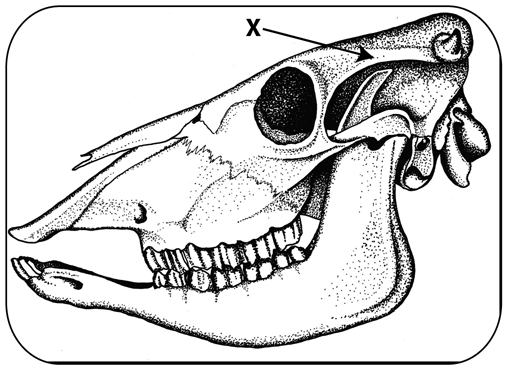
Polled Bulls
Horned or polled cows mated to a naturally polled bull (Angus) will give birth to polled calves. However, some non-naturally polled bulls carry the gene for horns and will not breed true for the polled trait.
Advantages and Disadvantages
- welfare friendly
- availability of genetics for a specific beef or dairy breed
- selection for genetically polled is a trend for exotic breeds
- sensitive issue for horned Hereford breeders
Chemical Dehorning
Caustic chemicals will prevent the growth of horns when properly applied to the horn buds of new-born (less than one to three weeks of age) calves. The chemical destroys the horn-producing cells around the horn bud. The chemicals are available as sticks or pastes (Figure 2). To protect yourself, wear gloves when applying the chemicals. To protect the calf, avoid application near its eyes. Do not use caustics in rainy weather.
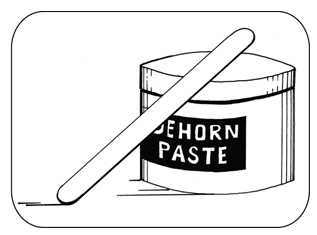
Technique
- Administer sedation, analgesia and local anaesthetic.
- Expose the horn bud (about the size of a 5-cent piece) by pushing the hair back (Figure 3).
- Apply the caustic to the horn button. Use a wooden applicator. Apply a thin layer.
- Re-position the hair over the paste and horn bud - i.e., cover the horn bud.
- Although the package insert may instruct operators to clip hair at the horn bud, experienced operators have shown that not clipping hair is preferable, because the hair keeps the caustic in place, reduces the risk of irritation to the cows udder and flanks and reduces irritation to other facial skin of the calf.
- Protect the calf and the cow from accidental caustic burns. One method is to place a patch of duct tape over each horn bud. The duct tape usually falls off in a few days. For dairy calves, keep in individual pens.
- In some countries, the technique is only permitted in calves less than eight days of age.
Advantages and Disadvantages
- performed at a young age with less stress than some other techniques
- bloodless
- use in any season
- painful without anaesthesia
- avoid contact with eyes; operator should wear gloves
- do not use in rainy weather
- not permitted in some countries
- horns or scurs follow improper technique
- requires pain control
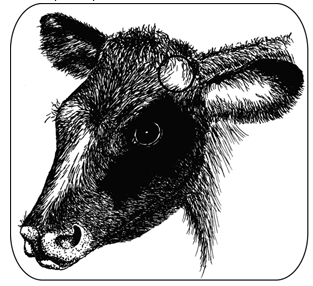
Hot Iron Dehorning
Hot iron dehorners are available in versions heated by a furnace or fire, 12-volt battery, 120-volt electricity, power packs (e.g., Buddex™) or LP gas (Figure 4). The head of the iron is a hollow circle and it fits over the horn bud. Proper application of the hot iron will destroy the horn-producing skin at the base of the horn. This technique works well for calves up to 12 weeks old. There are several sizes of dehorning irons. The proper size is one where the burner makes a complete ring around the base of the horn. For electric irons, use a short extension cord as voltage drops with a long cord, limiting the amount of heat generated by the dehorner.
Technique
- Administer sedation, analgesia and local anaesthetic.
- Preheat the dehorning iron to a red colour. Both electric and gas irons work best when they are "red" hot.
- Wear gloves to protect your hands.
- Hold the calf's ear out of the way to keep it from being burned.
- Place the tip of the burner over the horn and apply slight pressure. When the burning hair begins to smoke, slowly rotate the dehorner by twisting your wrist.
- Continue the application of heat for 10-15 seconds. Do not leave the dehorner in place for much longer, especially in young calves. Heat can be transferred through the thin bones of the skull and damage the calf's brain.
- Dehorning is complete when there is a copper-coloured ring all the way around the base of the horn.
- The horn bud or button will slough off in 4 to 6 weeks.
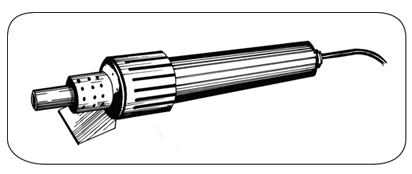
Advantages and Disadvantages
- bloodless
- can be used at any time of the year
- young calves up to 12 weeks of age
- unreliable when done incorrectly, leads to scurs (partial horn growth)
- requires expertise - pain control and technique
Dehorning Spoon or Tube
Dehorning spoons or tubes provide a quick and efficient technique for removing horn buds in calves less than eight weeks of age (Figure 5). With this method, a sharpened metal tube cuts through and removes the horn-producing skin at the base of the horn bud. Use the proper size tube to remove the horn plus about 1/8 inch of skin around the entire horn bud.
Technique
- Administer sedation, analgesia and local anaesthetic.
- Select the correct size tube (4 sizes available) to fit over the horn bud, and cover about 1/8 inch of skin around the horn base.
- Place the cutting edge straight down over the horn.
- Apply pressure to the tube; push and twist the tube until the skin has been cut through.
- Cut under the horn bud and remove it, using a scooping motion.
- Apply an antiseptic to the wound. Some bleeding may occur.
- Clean and disinfect the cutting edge of the tube between calves.
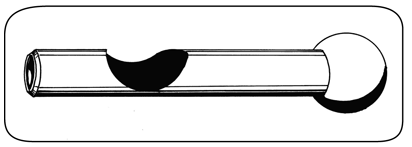
Advantages and Disadvantages
- not bloodless
- useful for young calves
- risk of infection because of open wounds
- avoid use during fly season
- unreliable when done incorrectly, leads to scurs
- requires expertise - pain control, technique, control of bleeding
Scoop, Gouge or Barnes-Type Dehorner
Scoop dehorners are used for calves ranging in age from two to four months with horns up to four inches long (Figure 6). Some operators claim better dehorning with a rectangular-shaped scoop because it removes an even ring of skin around and with the horn bud. When used properly, it does not go too deep, but the dehorner can open the frontal sinus when used at the top end of the age and horn-size range. The blades must be kept sharp for best results.
Technique
- Administer sedation, analgesia and local anaesthetic.
- Close the handles together.
- Place the jaws of the dehorner over the horn bud. The objective is to completely remove a ring of skin surrounding the horn base. Therefore, adjust the opening as needed (Figure 7).
- Press the gouger gently against the head. Maintain the pressure and quickly spread the handles apart to bring the blades together to remove skin and the horn bud.
- Control bleeding by pulling the artery with forceps or using a hot iron to cauterize the artery.
- Clean and disinfect the jaws of the gouger between calves.
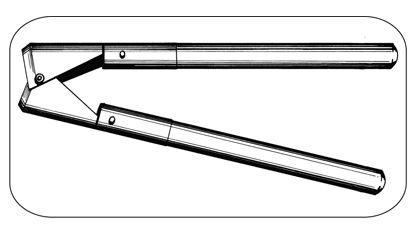
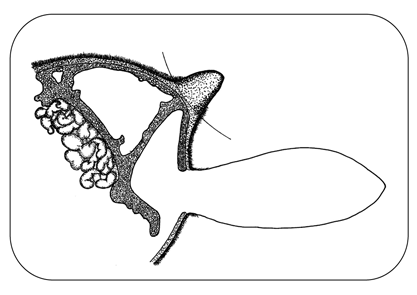
Advantages and Disadvantages
- fast - takes a few seconds to perform
- useful after the horn bud attaches to the skull
- not bloodless
- risk of infection because of open wounds
- opens the frontal sinus in older calves
- avoid use during fly season
- unreliable when done incorrectly, leads to scurs
- requires expertise - anaesthesia, sedation, analgesia and technique
- requires control of bleeding - pulling arteries or cautery
Aftercare
Dehorning and disbudding are surgical procedures. Calves require observation and aftercare following the surgery.
- Observe closely for bleeding for 30-60 minutes after dehorning.
- When bleeding is present, cauterize with a hot iron to stop the bleeding.
- Wounds usually heal well with no treatment.
- A fly repellant and a wound dressing are often recommended.
- For 10-14 days after dehorning, look for signs of infection and treat as needed.
- Get professional help for calves showing severe pain or infection.
Disinfection of Equipment
Diseases can be spread from animal to animal on dehorning equipment contaminated with blood. Enzootic bovine leucosis virus and the wart virus are two examples. It is essential to disinfect the tube and Barnes-type dehorners after each calf is dehorned.
Technique
- Rinse blood off with cold water after each calf is dehorned.
- Place the equipment into an antiseptic after the calf is dehorned.
- Change the antiseptic solution frequently to maintain its potency.
- Prepare a disinfectant solution by adding four ounces creosol to one gallon of water.
- Store the equipment only after cleaning and disinfecting.
The heat from electric dehorners effectively disinfects them between each calf. Hot-iron dehorners occasionally require cleaning with a wire brush.
Consult with your Veterinarian
This document describes procedures and techniques for dehorning young calves. Advantages and disadvantages exist for each method. Producers should consult with their veterinarian for advice prior to attempting unfamiliar procedures. Pain control (sedation, anaesthesia and analgesia) is necessary for dehorning calves.
January 2009

